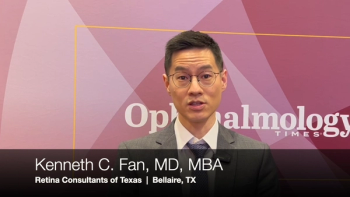
- Ophthalmology Times: February 2024
- Volume 49
- Issue 2
GA treatment advances: More work needed to achieve pinpoint therapeutic efficacy
Recent advances have moved the needle forward in the treatment of geographic atrophy (GA). However, more work is needed to determine which patients and lesions will benefit most from new therapies, according to Bani Antonio-Aguirre, MD, and J. Fernando Arevalo, MD, PhD, both of the Wilmer Eye Institute, Johns Hopkins School of Medicine, in Baltimore, Maryland. Knowledge gaps also exist regarding the development of neovascular age-related macular degeneration (nAMD).
According to a study,1 AMD is a vision-robbing disease in individuals 50 years and older. The disease has a prevalence rate of 8.7%,2 and this will continue to increase over time as more and more individuals are affected. The data underscore the importance of the current research into the discovery of new therapies.
Study details
The investigators undertook a recent review1 of the current knowledge of GA, including risk factors, prevalence rates, genetic associations, imaging findings, and advances in treatment. “The goal of starting this discussion is to ultimately identify the most suitable candidates for each therapy, highlight the importance of tailoring treatments to individual cases, and continue monitoring the long-term implications of these emerging interventions,” the researchers said.
In a major breakthrough, the FDA recently approved pegcetacoplan injection (Syfovre; Apellis Pharmaceuticals), a complement C3 inhibitor, as the first treatment for GA. Other approaches are being investigated in phase 2 and 3 trials.
In light of the ongoing research, Antonio Aguirre and Arevalo noted that “the long-term implications of these medications and interventions are still being monitored. While therapies aiming to block the complement cascade generally have a safe profile, we are still uncertain about the extent to which they will affect the quality of life and visual prognosis of [patients with] GA. Currently, we know that drugs inhibiting the complement have the potential to slow or halt the disease progression.”
In contrast, a recent meta-analysis of results from 242 patients reported inconclusive evidence regarding the ability of pegcetacoplan to slow visual loss.3
Identifying effective lesion-specific treatments is another challenge. A study of avacincaptad pegol (Izervay; Iveric Bio), a complement C5 inhibitor, found that treating patients with extrafoveal lesions with avacincaptad pegol achieved greater slowing of disease progression compared with treatment with pegcetacoplan, the trials of which included subfoveal and extrafoveal lesions. “This finding underscores the importance of tailoring treatments to specific lesion types for optimal outcomes,” they commented.
Another future goal is determining the risk of development of nAMD. Because the risk seems to be dose dependent, establishing monitoring protocols and assessing patients with risk factors for the development of nAMD must be undertaken.
Gene and cell therapies are emerging treatments, and more research is needed into their subretinal delivery. “Ensuring proper training and expertise in administering these treatments will be essential for their successful implementation,” the researchers added. “Additional therapies, such as microcurrent stimulation, will require further investigation to assess their long-term effects, optimal regimens, and whether they could be effectively utilized in conjunction with other therapies.”
Unknown impact
The effects of the novel drugs, cell therapies, and gene therapies on the progression from intermediate to late AMD are unknown. The authors pointed out that because clinical trials have focused mainly on GA, the potential for these therapies to delay or prevent progression from intermediate to late-stage AMD must be investigated.
“While progress has been made in treating patients with GA, several crucial considerations need to be addressed,” the researchers concluded. “Identifying the most suitable candidates for these therapies, tailoring treatments to specific lesion types, assessing the risk of nAMD, and understanding the impact on disease progression from intermediate to late AMD will guide future advancements in the field.”
References:
Antonio-Aguirre B, Arevalo JF. Treating patients with geographic atrophy: are we there yet? Int J Retina Vitreous. 2023;9(1):72. doi:10.1186/s40942-023-00493-6
Wong WL, Su X, Li X, et al. Global prevalence of age-related macular degeneration and disease burden projection for 2020 and 2040: a systematic review and meta-analysis. Lancet Glob Health. 2014;2(2):e106-116. doi:10.1016/S2214-109X(13)70145-1
Tzoumas N, Riding G, Williams MA, Steel DHW. Complement inhibitors for age-related macular degeneration. Cochrane Database Syst Rev. 2023;6(6):CD009300.
doi:10.1002/14651858.CD009300.pub3
Articles in this issue
over 1 year ago
IKA Keratoconus Symposium: Expanding visionover 1 year ago
Ophthalmology in paradiseover 1 year ago
Zeroing in on standalone glaucoma treatment optionsalmost 2 years ago
Ocular gene therapy: The good, the bad, and the maybealmost 2 years ago
An approach to preventing progression of pediatric myopiaNewsletter
Don’t miss out—get Ophthalmology Times updates on the latest clinical advancements and expert interviews, straight to your inbox.



















































.png)


